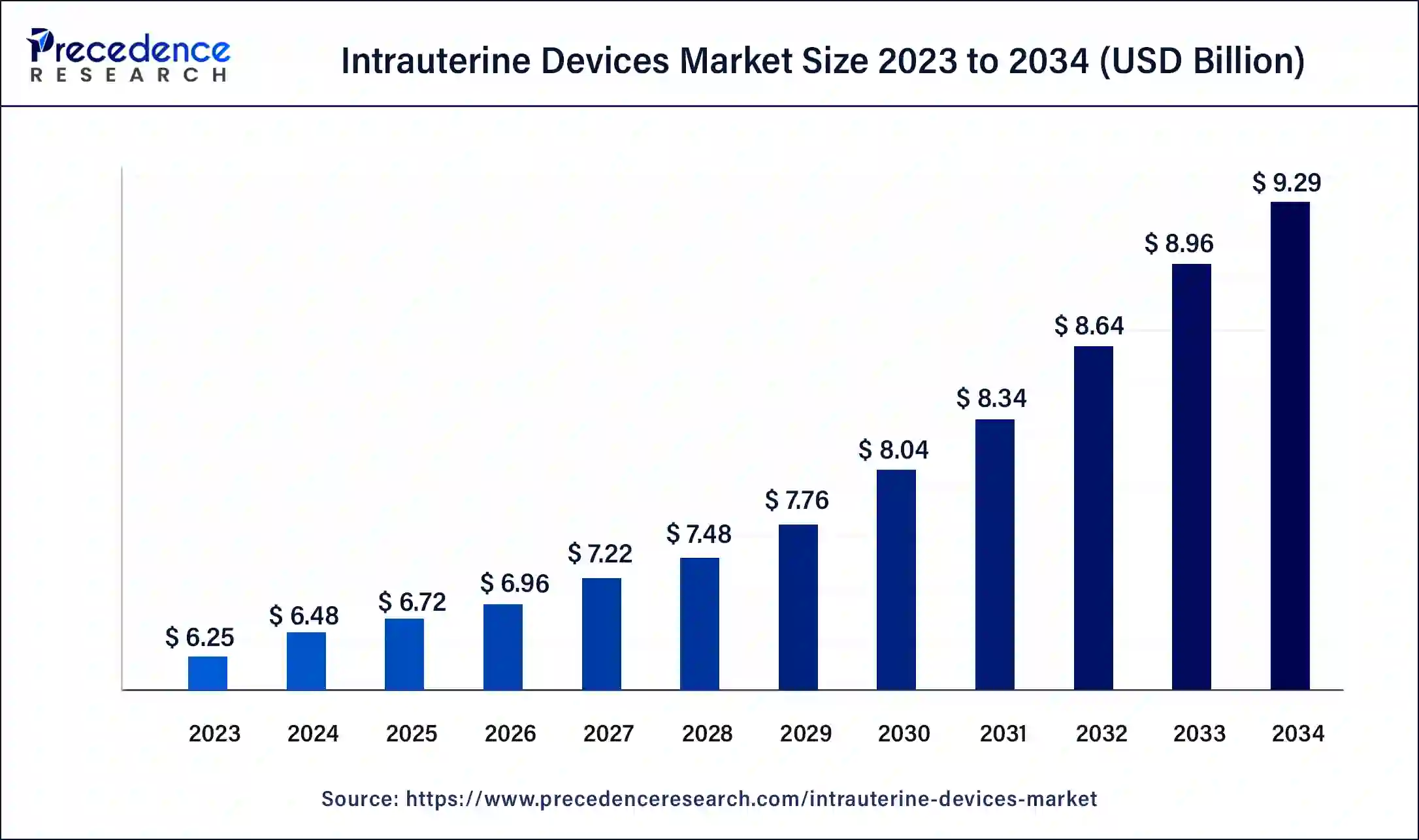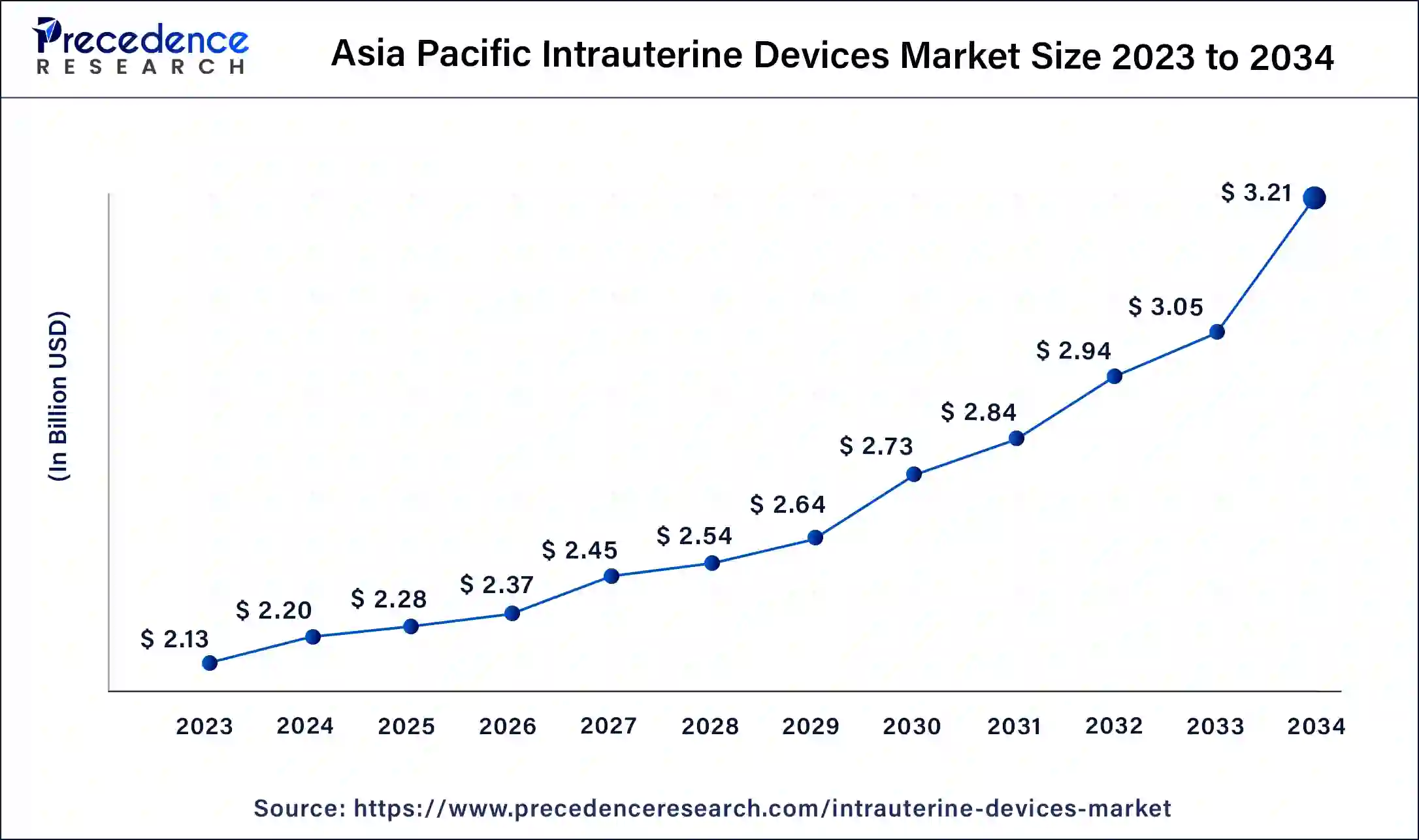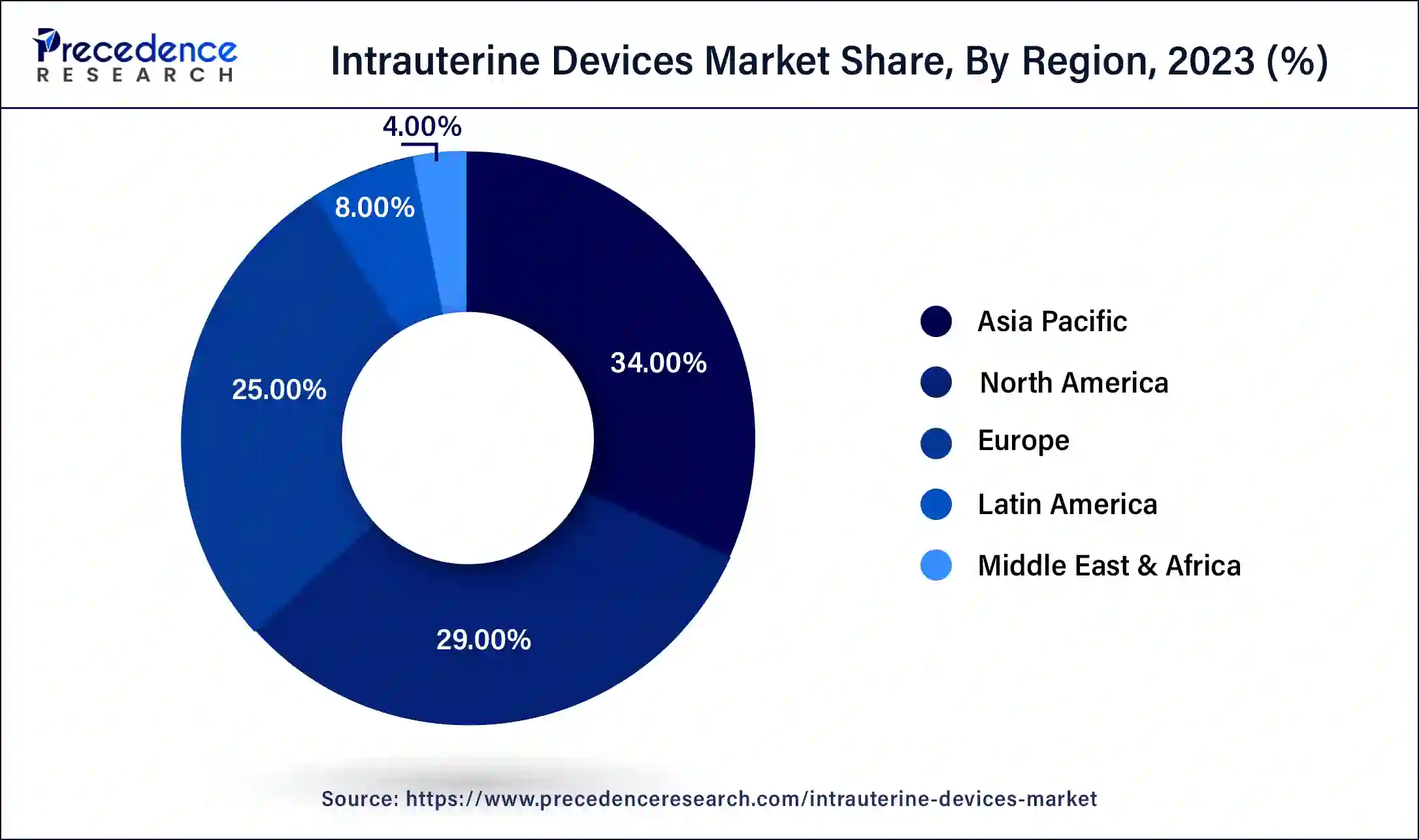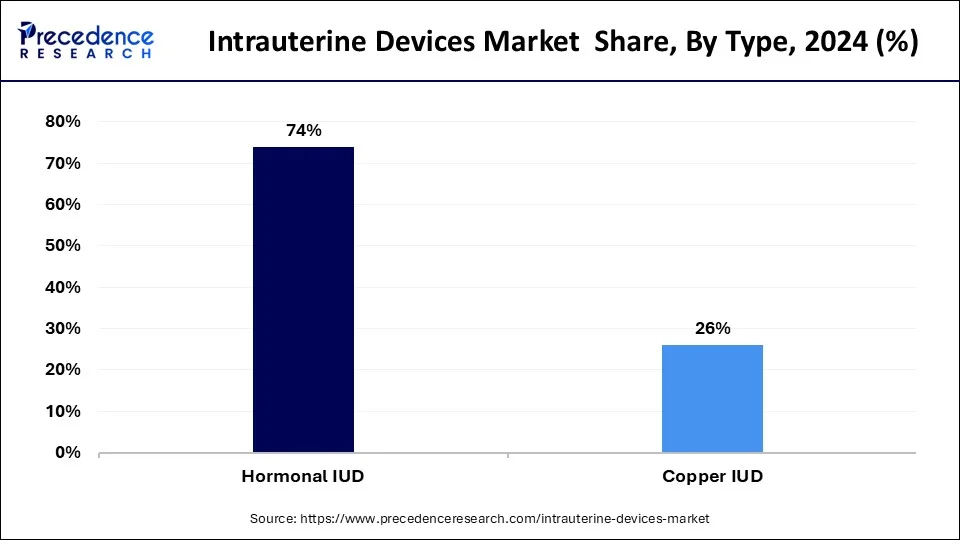April 2025
The global intrauterine devices market size was USD 6.25 billion in 2023 and is estimated at USD 6.48 billion in 2024 and is anticipated to reach around USD 9.29 billion by 2034, expanding at a CAGR of 3.67% from 2024 to 2034.
The global intrauterine devices market size is expected to be worth USD 6.48 billion in 2024 and is anticipated to reach around USD 9.29 billion by 2034, growing at a CAGR of 3.67% over the forecast period 2024 to 2034.

The Asia Pacific intrauterine devices market size was accounted at USD 2.13 billion in 2023 and is projected to be worth around USD 3.21 billion by 2034, poised to grow at a CAGR of 3.79% from 2024 to 2034.

Asia Pacific held the largest share of the intrauterine devices market in 2023. High population growth and rapid urbanization have increased the demand for contraception, with several government initiatives in the region being undertaken to promote family planning. Higher healthcare infrastructure spending, women empowerment initiatives, and the rising acceptance of modern contraception are all driving growth in the intrauterine devices market. Among countries in the region, China held a significant share of the market while India is expected to see a high CAGR in the space during the forecast period. Indian government initiatives such as ‘Mission Parivar Vikas’ are being undertaken to improve access to contraceptives and family planning services in 145 districts across seven states.

North America is projected to see notable growth in the intrauterine devices market in the coming years. The growing awareness and popularity of long-term birth control measures in the region are contributing to demand. According to the United States National Center for Health Statistics’ National Survey of Family Growth, 20.4% of sexually experienced women had used an IUD between 2015 and 2019, with 15.3% of them using hormonal IUDs.
Intrauterine devices, commonly known as IUDs, are small, T-shaped devices that are inserted into the uterus to prevent pregnancies. Earlier versions of IUDs all used copper to prevent conception; thus, the devices were widely known as the ‘copper T.’ However, modern intrauterine devices now come in two types: copper and hormonal.
Intrauterine devices are reliable, long-lasting, and reversible, making them a popular choice of contraception. Increasing consumer awareness around various methods of contraception and pregnancy prevention is leading to more individuals opting for long-term contraceptives, driving demand in the intrauterine devices market. However, the nature of the devices requires insertion by a trained healthcare professional, restricting their adoption in regions where access to physicians and trained nurses is limited. Innovations in intrauterine device technologies and material usage provide opportunities for expansion of the intrauterine devices market.
How artificial Intelligence is transforming the contraception sector?
Artificial Intelligence is making waves in the medical sector, including in sexual and reproductive healthcare. Machine learning is currently being applied to radiology and pathology to optimize the processing of large volumes of medical imaging data. Generative AI and large language models are also being employed to address a varying set of health needs through remote consultation via. chatbots and virtual assistants. Reproductive health services use AI tools such as conversational agents, which prove crucial in an area where patient anonymity is desirable.
Predictive AI capabilities also have the potential to address the need for targeted healthcare interventions, especially in areas where there is a shortfall of human resources, such as with maternal health or the management of STIs. AI is being used to analyze a person's medical records, lifestyle, and other wellness parameters to suggest the most suitable and effective form of contraception for them and even forecast the incidence of infertility.
| Report Coverage | Details |
| Market Size by 2034 | USD 9.29 Billion |
| Market Size in 2023 | USD 6.25 Billion |
| Market Size in 2024 | USD 6.48 Billion |
| Market Growth Rate from 2024 to 2034 | CAGR of 3.67% |
| Largest Market | Asia Pacific |
| Base Year | 2023 |
| Forecast Period | 2024 to 2034 |
| Segments Covered | Type, Distribution Channel and Regions |
| Regions Covered | North America, Europe, Asia-Pacific, Latin America and Middle East & Africa |
Rising awareness around contraception and preventing unwanted pregnancies
Government efforts on a global scale to tackle issues related to population explosion and the advent of the internet have led to increased awareness among consumers concerning different methods of contraception and their efficacy. Among the various forms of contraception, intrauterine devices are popular as they are seen as a long-term, reliable, and reversible method for women, offering high pregnancy prevention rates (total pregnancy rate of 1.7 per 100 women for the first 3 years of use), and a low expulsion rate (first-year expulsion rates of the IUD are commonly quoted as 2%-10%). Depending on the IUD’s make and model, it has a lifespan between 5 and 10 years. This is driving demand in the intrauterine devices market.
Investment initiatives in contraceptives on a global scale
Several government programs have been initiated worldwide for the promotion of family planning, tackling issues such as unwanted pregnancies. Organizations such as the National Institutes of Health (NIH), the Agency for International Development (AID), private foundations, as well as pharmaceutical companies, and venture capitalists are pledging significant investments in reproductive care. The United States Agency for International Development has partnered with country governments and local stakeholders since 2017 to procure and distribute over 563.5 million contraceptives, valued at US$ 251 million. According to the 2022 United Nations World Family Planning Report, in sub-Saharan Africa, there has been an increased share in the use of implants and injectables due to extensive investment by international donors and efforts by local authorities over the past two decades. There are also notable investments in developing new contraceptive technology to reduce repeat clinical visits. These investments are further boosting growth in the intrauterine devices market.
Lack of skilled professionals, especially in underdeveloped areas
Unlike other contraceptive methods, such as condoms or the pill, intrauterine devices are less accessible. Individuals cannot do IUD insertions, requiring trained healthcare professionals and specialized tools to administer them. Individuals wanting to use IUDs for pregnancy prevention are thus forced to rely on local healthcare facilities and clinicians to access this form of birth control. According to 2019 data published by the United Nations, 340 million people used either the male condom or the pill compared to 159 million using IUDs. The ease of use of other contraception methods is proving to be a significant challenge for growth in the intrauterine devices market.
Patient anxieties around intrauterine device insertion
Another common barrier to the use of IUDs is the fear of pain during insertion and anxiety surrounding the experience. Most women experience cramping during the insertion procedure but report that their healthcare providers fail to give them access to adequate pain management before, during, or after the procedure and even invalidate or minimize their pain. Research shows that clinicians in the United States were much more likely to prescribe sedatives for women in pain rather than pain medication compared to their prescriptions for pain in men.
Providers were also half as likely to prescribe Black patients pain medication as their white counterparts, compounding the effect for Black women. A 2015 study found that among women who had never given birth, 42% said that during the IUD placement, they experienced severe pain, with 35% rating it as moderately painful and 23% reporting it as mildly painful.
Development of new IUD technologies
Innovations in the sexual and reproductive healthcare sector are leading to the development of new types of IUDs as well as monitoring systems for serious issues such as IUD malpositioning, which increases the risk of ectopic pregnancies and life-threatening bleeding. In 2023, researchers at Cornell created the MyUD device, which incorporates a strain-sensitive circuit and resonant inductive coupling technology to detect malpositioning of the IUD within the uterus. The device is set up to warn users of any abnormal strain on the IUD that may result in displacement, perforation, expulsion, or embedment. New developments in the reproductive healthcare space are expected to drive future growth in the intrauterine devices market.
The hormonal IUD segment held a dominant presence in the market in 2023. Hormone IUDs work by releasing small amounts of progestin hormone Levonorgestrel over a period of time. Levonorgestrel thickens the cervical mucus, making it harder for sperm to swim toward the fallopian tubes. The hormone also works to thin the uterus lining and partially suppresses ovulation. Hormonal IUDs have also been found to ease menstrual pain and heavy bleeding and may even stop periods altogether. Hormonal IUDs provide a 99.8% pregnancy prevention rate and are also helpful in the treatment of menorrhagia and dysmenorrhea, making them a popular choice among modern contraceptives.

The copper IUD segment is observed to grow at a notable rate during the forecast period in the intrauterine devices market. Copper IUDs work by triggering an immune response in the body, causing inflammation in the uterus which prevents pregnancy. Copper IUDs were the most widespread form of IUDs used before the development of Levonorgestrel-based IUDs. They continue to remain popular in middle and low-income countries due to their longevity (10-year lifespan) and lower cost.
In 2023, the hospital segment led the global intrauterine devices market. IUDs require administration by trained professionals, and hospitals worldwide are the primary providers of family planning services, including counseling and follow-up visits. The number of patient visits for family planning to hospitals is also expected to drive further growth in the market.
The gynecology clinics segment is predicted to witness significant growth in the market over the forecast period. Gynecology clinics are increasingly catering to women’s reproductive healthcare needs, especially in areas where healthcare infrastructure is lacking. These clinics provide services such as pap smears, breast cancer screenings, pelvic pain evaluations, and helping patients find the most suitable contraception method.
Recent Innovation in Intrauterine Devices Market
By Type
By Distribution Channel
By Geography
For inquiries regarding discounts, bulk purchases, or customization requests, please contact us at sales@precedenceresearch.com
No cookie-cutter, only authentic analysis – take the 1st step to become a Precedence Research client
April 2025
January 2025
January 2025
February 2025